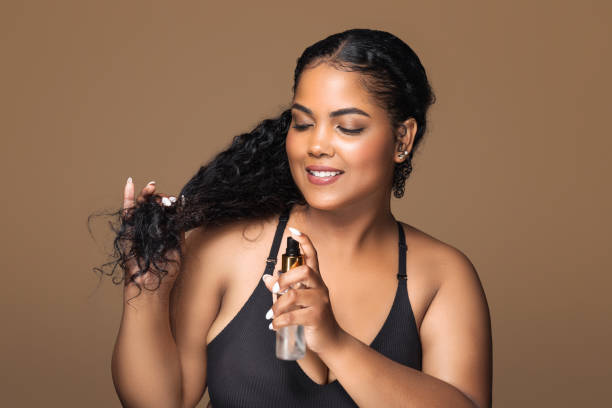Sleeping with wet hair can be convenient, especially if you have a busy schedule and don’t have time to dry your hair before bed. However, sleeping with wet hair can be tricky, especially for Black women with textured hair. Wet hair is more fragile, making it prone to breakage, tangles, and even mildew buildup if not properly cared for.
However, if you find yourself needing to sleep with wet hair due to one happenstance or another, there are ways to protect your curls and coils while preserving moisture and preventing damage. Here’s how to sleep with wet hair.
Why Wet Hair Needs Special Care
When your hair is wet, the cuticles are more open, making the strands more susceptible to breakage and damage. Textured hair, particularly coiled and curly types, is naturally more delicate than straight hair. Additionally, friction between wet hair and your pillow can lead to tangles, split ends, and frizz. Not only that, but keeping your scalp damp for prolonged periods can encourage mildew, mold or bacteria buildup, particularly if your hair is in braids or twists. If your hair is in tight micro braids, it’s heavily advised that you not go to bed with wet hair if possible.
So, if you have no choice at all, how do you sleep with wet hair? Properly preparing your hair before going to bed minimizes the associated risks, keeping your locks in great condition.
Remove Excess Moisture
If you’re trying to figure out how to sleep with wet hair, it can be assumed that drying it out fully is out of the question. Still, if possible, you’ll want to remove as much moisture as you can.
Start by gently blotting your hair with a microfiber towel or tee-shirt to remove excess water. Microfiber towels are softer and more absorbent than regular towels, which means they cause less friction and are gentler on your hair. Avoid rubbing your hair vigorously, as this can cause breakage and frizz.
Apply Leave-In Conditioner
After towel-drying your hair, apply a leave-in conditioner or a lightweight hair serum. These products help to lock in moisture, reduce frizz, and protect your hair from damage. Focus on the ends of your hair, as they tend to be the most fragile and prone to splitting.
An overnight hair treatment can also nourish and protect your hair while you sleep. There are various treatments available, such as hair masks, oils, and serums, that can provide deep conditioning and repair. Make sure to apply the treatment to your hair before bed and rinse it out in the morning for soft, hydrated locks.
Enlist a Protective Style
Braiding your hair before bed is a great way to protect it and reduce tangles. For textured or curly hair, protective styles can come in handy in a big way. If you have the time and resources, consider locking your hair up in a protective style before going to sleep with it wet.
Loose braids or twists will help keep your hair in sections, which will keep shrinkage and breakage at bay. Plus, it’ll encourage even drying. If you’ve got looser curls, gathering them at the top of your head (picture a pineapple) will maintain volume, keeping you from waking up with a flattened head of hair.
Use a Silk or Satin Pillowcase
Switching to a silk or satin pillowcase can make a significant difference in protecting your wet hair while you sleep. Satin pillowcases help to improve the overall condition of your hair. Unlike cotton pillowcases, silk and satin create less friction, which helps to reduce frizz and breakage. Additionally, these materials are gentler on your skin, making them a great choice for your overall beauty routine.
Consider a Hair Wrap or Cap
Don’t have a silk pillowcase? Try a satin or silk bonnet or scarf instead. Wearing a hair wrap or cap made of silk or satin can provide an extra layer of protection for your wet hair. These accessories help to keep your hair in place, reduce friction, and maintain moisture. This extra layer of protection keeps your hair smooth and prevents it from rubbing against your pillow. They are especially useful for those with curly or textured hair, as they help to preserve your natural curl pattern.
Always Use a Wide-Tooth Comb
Before going to bed, gently detangle your hair using a wide-tooth comb. This type of comb is less likely to cause breakage compared to a brush or fine-tooth comb. Start at the ends of your hair and work your way up to the roots, being careful not to tug or pull on your hair.
How to Sleep With Wet Hair: The Morning After
Congratulations, you slept with wet hair. Now, it’s time for a bit of damage control. If you have access to one, use a diffuser on a cold setting to speed up drying if your hair is still wet. If your hair type facilitates it, use a pick or your fingers to gently separate your hair to add volume without creating a head of frizz.
If your hair is feeling a little worn out and dry, spritz it with a lightweight leave-in conditioner or water-based mist. This will help breathe some moisture back into your hair.
Sleeping With Wet Hair: A (Sometimes) Necessary Evil
While it’s best to avoid sleeping with wet hair, sometimes it’s unavoidable. By taking the right precautions—like protective styling, reducing friction, and using the right products—you can minimize damage and wake up with healthy, hydrated hair.
Sleeping with wet hair doesn’t have to mean compromising your hair’s health and overall appearance. Remember to be gentle with your wet hair, use the right products, and take preventive measures to reduce friction and damage. With a little extra care, you can enjoy the convenience of sleeping with wet hair without the worry of breakage and frizz.
